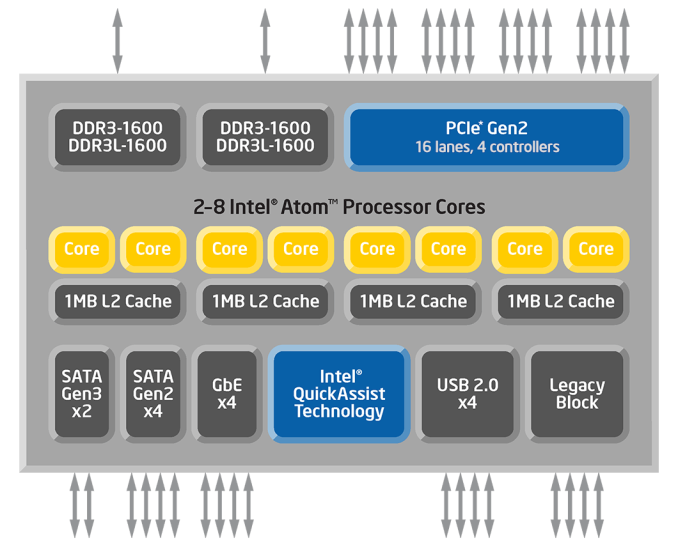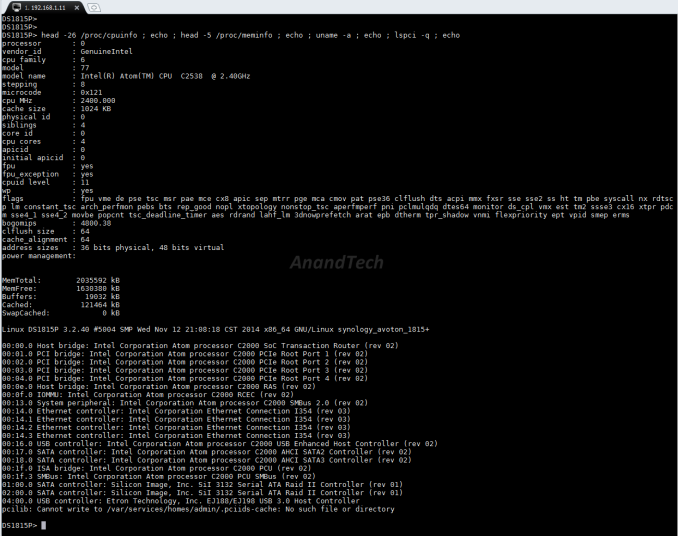Synology DS1815+ 8-bay Intel Rangeley SMB NAS Review
by Ganesh T S on November 18, 2014 6:30 AM ESTPlatform Analysis
The higher end segment of the SOHO / SMB NAS market uses Intel's Core-series and Xeon CPUs to deliver the required performance while supporting a large number of drive bays (typically more than 8, in a rackmount form-factor). Over the last four years or so, Intel's play in the other tiers has been mainly with its Atom CPU lineup. Back in 2010, Intel pushed the 45 nm Atom D410 / D510 / D525 for NAS units. In 2012, it was the 32 nm Atoms, the D2550 and D2700. All of these were based on the in-order Bonnell microarchitecture which was fast becoming dated compared to the advancements being made by the ARM SoC vendors. In moving from 32nm to 22nm, Intel completely revamped the microarchitecture for their Atom cores. Bonnell was replaced by Silvermont, bringing out of order execution and other improvements into the picture. Silvermont's applicability to a variety of power profiles meant that there were multiple product lines that ended up using the CPU cores. Bay Trail is proving very effective in tablets and also makes up QNAP's TS-x51 and TS-x53 Pro NAS series. Merrifield and Moorefield are trying to break into smartphones, but it is Avoton and Rangeley that are more relevant to the storage appliances market.
The different product lines integrate different I/O around the Silvermont cores depending on the target market. Avoton is meant for microservers and cloud storage platforms, while Rangeley is meant for communication and network infrastructure. Both of them integrate similar I/O around the cores, but the Rangeley parts have an updated crypto engine. The block diagram of a generic Rangeley part is provided below.
There is a wealth of I/O (2x SATA Gen 3, 4x SATA Gen 2 and up to 16 PCIe 2.0 lanes) for the storage subsystem, and the parts also support up to 4x 2.5 Gbps network links. From the viewpoint of the Synology DS1815+, the above block diagram should be considered in the context of the information gleaned via SSH access to the unit.
The DS1815+ uses the Intel Atom C2538 SoC which has four Silvermont cores running at 2.4 GHz. It is backed up by 2 GB of DRAM. The Atom C2538 has 16 PCIe 2.0 lanes. The Silicon Image SiI3132 PCIe to 2-port SATA II host controller uses a single PCIe 2.0 lane on the host side. There are two of them using up two PCIe 2.0 lanes in total. Unlike the DS415+ in which the USB 3.0 ports were provided by the Etron EJ168 USB 3.0 host controller, the DS1815+ uses the Etron EJ198. This USB 3.0 host controller uses two PCIe lanes to enable the four USB 3.0 ports found on the rear side of the unit. The four Ethernet controllers are all based on the Intel I354. Despite being 2.5G-capable, the transceivers they are connected to make them GbE ports.
The more interesting hardware aspect is the absence of any PCIe to SATA bridges for the internal ports. Given that the C2538 has only a total of six SATA ports (2x SATA III and 4x SATA II) and there are no bridges in the SSH report, it can be inferred that a port multipler (1x SATA host to 2x SATA device) such as the ASMedia ASM1092 must be in use. However, without opening up the unit (which we haven't done yet, given our limited time to bring out the review), this can't be confirmed.
On the software front, the DS1815+ runs Linux (kernel version 3.2.40). We have covered DSM 5.0's setup and usage impressions in our recent DS214play and DS414j reviews. There is not much point in rehashing the same excellent setup and usage experience. That said, with the ioSafe 1513+, we also started looking at iSCSI support in NAS units. We will be looking at that aspect in this review also.












65 Comments
View All Comments
DiHydro - Wednesday, November 19, 2014 - link
A full time employee making ~$40k a year can cost a company about ~$55k a year, and even then, having vendor support and warranty can leave them free to do other support tasks.CalaverasGrande - Thursday, November 20, 2014 - link
Half hour to set up linux? Sure that is possible. But that is hardly typical for soup to nuts, setting up Suse/Debian/Ubuntu, configuring network, doing the inevitable updates, then configuring drives as arrays, iScsi targets etc.Unless you are on a 'nix machine everyday most of us will have to google or man how to do this or that in regards to building an array, setting up certain services we want available and so on.
Linux is certainly powerful, but it is not terribly user friendly for the average consumer.
As far as 'proven', Synology, Qnap and Drobo have all been doing this NAS thing for a while. They are pretty mature, and have certain features that have evolved in response to their user base. While these are not impossible or even hard to replicate on Linux, Windows or OS X, they are already there on most of these NAS. Even in business IT we sometimes lean on these consumer grade NAS for certain low impact applications. (we actually used a Drobo on a project a couple years ago, not my call actually)
You open the box, plug it in, beep boop, it works. There is value to that, expecially if you dont have a shelf full of spares in the back and if you already spent all day working on technical stuff and just want it to work.
SirGCal - Friday, November 21, 2014 - link
"Half hour to set up linux? Sure that is possible. But that is hardly typical for soup to nuts, setting up Suse/Debian/Ubuntu, configuring network, doing the inevitable updates, then configuring drives as arrays, iScsi targets etc."It's soooo complicated... Insert boot CD/DVD. Follow prompts... In 5 minutes the system is running with the networks, graphics, sound, etc already fully configured (assuming you are using a desktop/server with desktop GUI version, even faster without). Run the update which is a one-liner and takes another 2 minutes. That's the whole point, it's not bogged down by Microsoft's horrible server communication and 'update' system. Then plug in the X drives and run a few simple commands easily found with google in less then 3 minutes (to do the full ZFS install, it takes 3 and that's including another 'update')... Setup your array pool, ok that might take 10 minutes... and cron a watchdog script to monitor the array and email you if there is an issue... Setup shares.. Ohh.. done. Good lord how slow do you people work? when I lost an OS drive on one of the array boxes and had to stick in a new one, I went from empty system to fully up and re-running again in 10 minutes. It just doesn't take long with Linux. It is long since 'Proven' itself and been tweaked for the fast installers. Want an even faster and more like Syn system, use FreeNAS. Hell, don't even need a boot up HDD/SDD. It can live and run from a USB drive and do all of the above also. Ideal for copying something like a Syn. Can do all that and more. It's a more specific version of FreeBSD. All just another flavor of Linux. It's just not the hard OS it used to be and even Syn runs a flavor of Linux Kernel as the Synology DSM tweaked by it's developers. It's all the same. But as many Syn users learned last year, being 'unique' also makes it a target for viruses. That's why Windows gets so many and other OSs don't get as much. But when the users wanted to 'lock' the Syn boxes and hold them up for hostage, it wasn't that difficult to write a virus to target that. That's one very large problem with proprietary OSs.
evilspoons - Wednesday, November 19, 2014 - link
Laziness is not the factor. It's warrantied performance and reliability vs the hourly costs of screwing it around to figure it out yourself. For a home/tech user you might see this as a side project; for someone at a small engineering company that can't afford an IT department the boss would see me building an array myself as something holding business-critical data that could blow up on its own without a phone number to call for help AND me spending like 4-8 hours of time I could otherwise be doing engineering billable at $180/hr. Tada, it just paid for itself.SirGCal - Wednesday, November 19, 2014 - link
So then you're a multi-millionare making $180 an hour.. Trade ya... I make plenty to give $ away every holiday just cause I can, but I don't have anything like that...DiHydro - Wednesday, November 19, 2014 - link
As a business, if the file server goes down, then it's down time multiplied by how many employees you have. Could be way, way more than $180 an hour that the owner is losing.SirGCal - Friday, November 21, 2014 - link
Then they shouldn't have mission-critical information on something so vulnerable. Not even on something like my own boxes. That's the companies own fault for not having proper data protection for mission critical information.Beany2013 - Thursday, November 27, 2014 - link
No, it's your fault for not *telling* them that's what they need, and not refusing to work with them till they agreed to let you build that sort of redundancy into the system. Not spThat's why I'm glad I'm out of working with SMBs and SOHOs - I don't have to fix half-baked solutions like yours any more.
I assume you are using 5gb of RAM per TB for dedupe, unless of course you *want* the server to page itself to a halt in a years time when you run out of memory?
I've spent a decade designing and installing system, storage and network solutions for SOHOs and SMBs up to government level - people like you are a nightmare.
And yes, SMBs and SOHOs have been loving this kit for the last couple of years since the price/performance/featureset trifecta came through - because it means they don't have to deal with people like you, either.
Oh and you do realise that DSM is built around the Linux kernel, right? And that far from being proprietary, it's Linux and MDADM? To such a degree that if you need to recovery disks fast, you can just fire up MDADM, recreate the VG and copy the data off from a live Ubuntu CD?
https://www.synology.com/en-us/knowledgebase/faq/5...
As for Synolocker, if you leave port 389 open to the internet on a Windows box you'll be FUBAR PDQ too - but as a good sysadmin, you'd only let remote users access the box via obfuscated ports at worst, or a VPN connection so you'd not have been touched by it...nothing to do with proprietary (See ShellShock for details - thats proper FLOSS and still got humped) and everything to do with being poorly advised on setup and config.
By people like you. Who think that BSD is a flavour of Linux. Hint - it's not. Linux was developed specifically because it's *not* Unix. Do the damned research....
evilspoons - Thursday, November 20, 2014 - link
Are you kidding? That's a normal engineering rate. I don't get paid that, the COMPANY bills that. That is what keeps the lights on. I can't bill the customer $180/hr when I'm setting up a RAID array, but I can when I'm actually WORKING ON THEIR PROJECT.AbRASiON - Sunday, November 23, 2014 - link
I built a 30TB FreeNAS box and while I enjoyed it - this has little to do with the "the lazy" - I'd estimate it was at least 50 hours research in getting it humming properly and I'm relatively tech savvy.